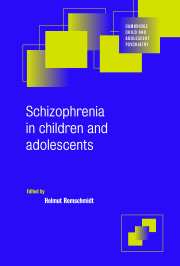Book contents
- Frontmatter
- Contents
- List of contributors
- Preface
- 1 Childhood psychosis and schizophrenia: a historical review
- 2 Definition and classification
- 3 Epidemiology of early onset schizophrenia
- 4 Childhood schizophrenia: developmental aspects
- 5 Diagnosis and differential diagnosis
- 6 Genetic aspects
- 7 Neurobehavioral perspective
- 8 Psychosocial factors: the social context of child and adolescent onset schizophrenia
- 9 Treatment and rehabilitation
- 10 Course and prognosis
- Index
5 - Diagnosis and differential diagnosis
Published online by Cambridge University Press: 23 October 2009
- Frontmatter
- Contents
- List of contributors
- Preface
- 1 Childhood psychosis and schizophrenia: a historical review
- 2 Definition and classification
- 3 Epidemiology of early onset schizophrenia
- 4 Childhood schizophrenia: developmental aspects
- 5 Diagnosis and differential diagnosis
- 6 Genetic aspects
- 7 Neurobehavioral perspective
- 8 Psychosocial factors: the social context of child and adolescent onset schizophrenia
- 9 Treatment and rehabilitation
- 10 Course and prognosis
- Index
Summary
Introduction
The diagnostic construct of schizophrenia as applied to children assumes the principle of “developmental homotypy”. This view asserts that psychopathological disorders have similar presentations at different stages of development and it is implicit in the DSM-IV (APA, 1994) and ICD-10 (WHO, 1993) diagnostic criteria for schizophrenia. In producing a common diagnostic construct across the age range, less emphasis is given to the principle of “developmental heterotypy,” which asserts that the symptoms, or manifestations, of psychopathological disorders can vary with age.
The importance of the effect of developmental heterotypy in childhood and adolescence is illustrated by the example of Wilson's disease (hepatolenticular degeneration). In prepubertal children, Wilson's disease presents predominantly with hepatic symptoms, while in adolescence the symptom picture changes to one of a neurological syndrome – with extrapyramidal (parkinsonian) features. If the later onset symptom pattern alone was used to define the condition, then most prepubertal cases would be missed. In addition, the lack of specificity of the neurological symptoms would also make it impossible to distinguish “true” cases from those resulting from mimicking syndromes such as antipsychotic-induced parkinsonism. However, because the underlying pathogenesis of Wilson's disease is known and confirmatory diagnostic tests are available, it has been possible to show that quite different clinical presentations at different ages are manifestations of the same underlying disorder.
In contrast to Wilson's disease, it has been very difficult to establish the true extent of developmental variability of schizophrenic symptoms because the disorder is defined by its manifestations and there is no “gold standard” to validate clinical diagnosis.
Keywords
- Type
- Chapter
- Information
- Schizophrenia in Children and Adolescents , pp. 82 - 118Publisher: Cambridge University PressPrint publication year: 2000

